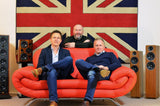Opera Loudspeakers Grand Callas
Opera Loudspeakers

The Company

Opera Loudspeakers was founded in 1989, but its origins go back to the early 1980s, to an unusual but highly fruitful synergy between two cultures and two audiophiles, one Italian and the other English. The first loudspeaker to bear the Opera name was called Caruso, and was the precursor of a series named in homage to the legendary voices of the lyric opera. Callas, Operetta and Divina soon followed, each gaining enthusiastic acclaim in the developed audio markets of the world. Opera loudspeakers immediately appeared as a fusion between the old and the new: between traditional Italian craftsmanship in cabinet-making and the most advanced acoustic technology. Every Opera loudspeaker, even the least expensive model, follows a tried and tested philosophy of design: the use of top quality materials allied to carefully applied basic principles of acoustic science. Today our loudspeakers are exported everywhere, from Europe to the Far East with relevant space on the most important hi-fi magazines.
Our intent is to create a complete line of high quality , beautiful to see and to listen to; we then developed over therefore also a line of accessories with the same principle that gave prestige to our speakers.
Gianni Maria Sacchetti, founder
Opera Grand Callas Loudspeaker
The new Grand Callas model is a three-way floorstanding speaker that replaces the previous model with the same name. This new version has been completely redesigned from top to bottom. In fact, the performance of this new Grand Callas is at the same level as our classic Tebaldi model, but with a significant reduction in footprint, room placement flexibility and price. This low-range loaded reflex design uses two 8” long-throw woofers, a 7" annealed polypropylene midrange and a 1" Scanspeak 9700 tweeter. The diffuser is complemented by a rear radiation system that uses two tweeters configured as a natural dipole.
It’s obvious we wanted to keep the best features of both the previous Grand Callas and Tebaldi models in order to offer high-quality sound in a flexible loudspeaker system that is easily adaptable to all environments. In addition, we needed to continue the tradition of the Grand Callas aesthetically pleasing design that’s also a particularly good value for the money.
The back radiation system uses two tweeters that are connected as a natural dipole. The performance of this dipole is virtually indistinguishable from the triplet used on previous Grand Callas. The rear radiation pattern feeds the reflected field without interfering with the direct sound while preserving the accuracy of the transient response. The rear radiation balances the power response and increases what we call “brilliance," a quality related to the perception of sound details. Improving the perception of detail also means improving the perception of "space."
The front panel of the cabinet of the new Grand Callas was shaped to make near-field listening possible, even when the listener is only a meter and a half from the loudspeakers. That’s because the Grand Callas is truly flexible and adaptable to various situations such as when reverberation time is not particularly low. The other feature that contributes to the flexible is the ability to modify the response of the low frequencies with a flick of a simple switch.
You can also choose to block the reflex ducts, which gives you four possible configurations for the Grand Callas. The occlusion of the ducts could be necessary when the speaker needs to be placed close to room corners. This allows the listener to place the speakers in the room and then find a better frequency response by adjusting the ducts and using the switch, as opposed to trying to find the right room placement and positioning in advance. You can also adjust the speakers with two different responses when, for example, you need to place one speaker closer to the wall than the other.
The Grand Callas 2014 produces a sound stage that expands effortlessly in three dimensions, with an excellent impulse response. The power, dynamics and extension at low frequencies is among our finest achievements.
Drivers
The two woofers are made by Scanspeak per Opera’s specifications. These 8” drivers feature an aluminum cone and rubber rim characterized by a magnetic group symmetrized (SD1) with flux stabilization rings. The force factor exceeds 10. This driver component, while cut off at 200 Hz, is able to work perfectly up to 1500 Hz. This guarantees a perfect overlap between the woofer and midrange two octaves before and beyond the cut-off frequency. For the same reason the midrange of the Grand Callas possesses a linear displacement of 12 mm peak-to-peak, which is also notable for a woofer design.
This displacement, apparently disproportionate, is exactly what you need to get pressure of 115 dB at 200 Hz The margin of safety is therefore more than adequate to ensure a level of intermodulation distortion that is very low. The diaphragm of the midrange is made with annealed polypropylene which has good internal damping but low stiffness. Subjecting it to a heat stress allows it to acquire rigidity without losing too much internal damping. The annealing, however, is a delicate process. Even the midrange has the magnetic circuit symmetrized with copper rings both above and below the T-shaped gap (a SEAS technology known as Excel).
The Scanspeak 9700 tweeter needs no introduction: it is one of the best tweeters ever made and, in some respects, is still unsurpassed. Currently, this tweeter is used on Opera models past and present such as Malibran, Caruso, Tebaldi and the new Opera Quinta 2014. Besides the excellent quality sound, this tweeter is also highly reliable.
Rear radiation system
Any system that reproduces high frequencies ultimately becomes directional. This means that the acoustic power emitted into the room decreases as the frequency increases. This phenomenon becomes important from about 2000 Hz up. To compensate for this effect, you can choose two solutions: using an omnidirectional source or using an auxiliary source that radiates toward the rear wall. The sound emitted from the auxiliary source inevitably interferes with the main radiation, degrading the impulse response of the system and negatively affecting clarity.
The solution is an auxiliary source that emits in all directions except along the axis of preferred listening. One such type of source (strongly anisotropic) is already present in nature--the dipole.
By connecting two tweeters in series and out of phase you get the kind of radiation required. In the past, Opera models such as Tebaldi, Malibran and Caruso implemented a dual dipole--the CLD with 4 tweeters. Then Opera introduced a triplet (three tweeters) for the Callas product line. Today, thanks to experience and our careful study of the geometry of the cabinet, we have reduced the auxiliary source to a "natural dipole" with only two tweeters.
The auxiliary source is equipped with its own crossover filter which adjusts the cutting and the attenuation as required. The effect of the rear dipole is evident: it is possible to align the front tweeter level without artificial boost, and the reproduction of the high range always sounds full but never aggressive. The end result is a sound is much more natural.The auxiliary source overworks the normal characteristics of phono absorption of domestic rooms which very rarely absorb sound in the high range of frequencies.
Cabinet
The Grand Callas is a speaker of considerable size, despite its relatively small footprint. The internal volume is 92 liters--80 liters are dedicated to the woofer alone. The midrange is loaded and suspended in a separate chamber. The cabinet is made from MDF and curved plywood with a thickness ranging from 25 mm (sides) to 50 mm (the front panel). The inside of the front panel, in correspondence of the holes of the loudspeaker, is milled so that turbulence does not arise in the vicinity of the speaker membranes. The inside of the cabinet is braced to connect the four vertical walls.
Two common problems with speakers are resonances of the cabinet and internal reflections. Regarding rigidity, this is governed by the thickness and the weight of the walls. In order to reduce internal reflections in the midrange, the midrange chamber is completely filled with sheets of open cell polyurethane foam with pyramidal profile (with base of 7 x 7 cm, and 3 cm and 7 cm for the basic height of the pyramid). This porous material, with its particular profile, provides a coefficient of 60% at 250 Hz and reaches almost 100% at 500 Hz. Strategically placing the right amount of this absorbent material inside the cabinet address both reflections (which would produce masking) and the normal modes of the cavity which would produce an annoying noise. The relationship between the moving masses and the mass of the cabinet is of the order of 1 to 1000 (1022 to be precise). This means that only a negligible part of the energy due to the motion of the speakers is transferred to the cabinet by promoting the "horizontal definition" or, as is often called, bass articulation.
Crossover filter
Normally, three-way crossovers are made up of three sections connected in parallel (woofer low-pass, midrange band-pass and high-pass for the tweeter). There is another way which, in our opinion, is more effective—a proven design that we began to use ten years ago with the Tebaldi. First we prepare the filter between woofer and midrange (Opera three-way speakers always have a cut-off at around 200 Hz or so). Then we treat to the whole woofer and midrange as a single transducer that possesses the volumetric displacement of the woofer but the radiation pattern of the midrange. To this "mid-woofer system" we apply the low pass needed to blend with the tweeter.
This crossover is therefore two sections in parallel (woofers and midrange) with a series low pass filter that is, in turn, parallel to the filter of the tweeter. This type of arrangement allows you to adjust the intersection between the midrange and tweeter without altering the phase relationships between the woofer and the midrange. If you set the crossover frequency to f, the phase is changed a decade before and a decade after the cut-off frequency. Even with a first cut at 200 Hz, the phase is changed up to 2 kHz, where the cut-off is located between the midrange and tweeter. On the other hand, you lose the possibility of tri-amping the system.
To build this crossover we use high quality components such as Mundorf capacitors, MOX resistors and OFC and auto-cementing inductors. In models such as the Grand Callas, the PCB that contains the filters of the tweeter is separate from the PCB that contains the filter mid-bass in order to eliminate the self-induction between the windings that add distortion that interferes with clarity.
Room Positioning
The sound quality produced by a pair of loudspeakers depends on a series of details: for example, by orienting the speakers towards the listening point you can adjust the depth of the sound stage. You can choose to subjectively make the speakers "cross over" in front of the listener (as shown), the head of the listener or behind the listener's head.
The Grand Callas model has a switch that regulates the emission of low frequencies. The effects of the switch normally depends on the relative position between the speaker and the room walls, so the listener should place the speaker in the listening environment and then try the switch position that seems subjectively better.
When there are many listeners in the room you may need to use two pairs with the diffusers arranged and connected as shown. Since the Grand Callas has a nominal impedance of 4 ohms, they must be connected in series.
Specifications
|
System |
Reflex, foorstanding with rear fireing radiation system (dipole). Finish in wood and leather. Bi-wiring. Support for spikes or wheels. |
| Front firing loudspeakers |
2 x 8” long-throw woofers, 1 x 7” midrange with polypropylene re-cooked cone and phase plug. 1 x 1” Scanspeak 9700 tweeter without ferrofluid and double decompression chamber |
| Rear fireing loudspeakers |
2 x1” tweeters in “natural dipole” assembly |
|
Number of ways |
3 ways + rear dipole |
| Frequency Response |
32 -25000 Hz |
|
Cross-over |
On 2 PCB |
|
|
12 dB/ott. For woofers |
|
|
12 dB/ott for midrange |
|
|
18 dB/ott for the front tweeter |
|
|
12 dB/ott for the reas tweeters |
|
|
Cross-over frequencies 200 e 2000 Hz (aprox.) |
| Max Power (long period) |
240 Watt (without clipping) for musical programs with crest factor about 3 |
| Max Power (Short period) |
500 Watt (without clipping) for musical programs with crest factor more than 5 |
|
Amplifier |
Starting from 10 Watt RMS |
|
Sensitivity |
89 dB/2.83 Volt/1 meter |
|
Nominal impedance |
4 ohm (Zmin >3.2 ohm) |
|
Position in the room |
At least 20 cm from the rear wall |
|
Size |
130 x 31 x 55 cm (HxLxP) |
|
Weight |
75 Kg each |
|
Finishing |
Walnut, Mahogay |














